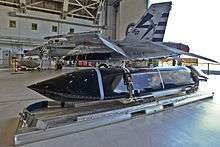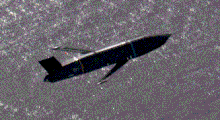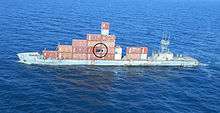AGM-158C LRASM
The AGM-158C LRASM (Long Range Anti-Ship Missile) is a stealthy anti-ship cruise missile developed for the United States Air Force and United States Navy by the Defense Advanced Research Projects Agency (DARPA).[9] The LRASM was intended to pioneer more sophisticated autonomous targeting capabilities than the U.S. Navy's current Harpoon anti-ship missile, which has been in service since 1977.
| AGM-158C LRASM | |
|---|---|
 A Long Range Anti-Ship Missile (LRASM) mass simulator integrated on an F/A-18E Super Hornet at NAS Patuxent River in 2015. | |
| Type | Anti-ship missile Cruise missile Air-launched cruise missile |
| Place of origin | United States |
| Service history | |
| In service | 2018 to present[1] |
| Used by | United States Navy United States Air Force Royal Australian Air Force |
| Production history | |
| Designer | DARPA |
| Manufacturer | Lockheed Martin |
| Unit cost | US$3,960,000[2] (FY 2021) $3 million[3] |
| Specifications | |
| Mass | 2,500 lb (1,100 kg) (air-launch)[4] 4,400 lb (2,000 kg) (w/ booster)[5] |
| Warhead | 1,000 lb (450 kg) blast-fragmentation penetrator[6] |
| Maximum speed | High-subsonic |
Launch platform | F/A-18E/F Super Hornet B-1B Lancer Mark 41 Vertical Launching System F-35 Lightning II Boeing P-8 Poseidon[7] [8] |
The Navy was authorized by the Pentagon to put the LRASM into limited production as an operational weapon in February 2014 as an urgent capability stop-gap solution to address range and survivability problems with the Harpoon and to prioritize defeating enemy warships, which has been neglected since the end of the Cold War but taken on importance with the modernization of the Chinese People’s Liberation Army Navy.
Competitors to Lockheed Martin protested the decision to award them a contract given the circumstances of selection and competition for the missile. The Navy responded by saying Lockheed's LRASM program was limited in scope, the decision to move ahead with them was made after an initial DARPA contract award, and that it was an urgent need to face future threats.
The Navy will hold a competition for the Offensive Anti-Surface Warfare (OASuW)/Increment 2 anti-ship missile as a follow-on to LRASM to enter service in 2024.[10] The OASuW Increment 2 competition will be completely open and start by FY 2017.[11] It is expected the LRASM will compete against the joint Kongsberg/Raytheon offering of the Joint Strike Missile (JSM) for air-launch needs and an upgraded Raytheon Tomahawk cruise missile for surface-launch needs.[12]
In August 2015, the missile was officially designated AGM-158C.[13]
Design
Unlike current anti-ship missiles the LRASM is expected to be capable of conducting autonomous targeting, relying on on-board targeting systems to independently acquire the target without the presence of prior, precision intelligence, or supporting services like Global Positioning Satellite navigation and data-links. These capabilities will enable positive target identification, precision engagement of moving ships and establishment of initial target cueing in extremely hostile environments. The missile will be designed with counter-countermeasures to evade hostile active defense systems.[14]
The LRASM is based on the AGM-158B JASSM-ER, but incorporates a multi-mode passive RF, a new weapon data-link and altimeter, and an uprated power system. It can be directed to attack enemy ships by its launch platform, receive updates via its datalink, or use onboard sensors to find its target. LRASM will fly towards its target at medium altitude then drop to low altitude for a sea skimming approach to counter anti-missile defenses. DARPA states its range is "greater than 200 nautical miles (370 km; 230 mi)."[15] Although the LRASM is based on the JASSM-ER, which has a range of 500 nmi (930 km; 580 mi),[16] the addition of the sensor and other features will somewhat decrease that range.[17] It is estimated that the LRASM has a range of 300 nmi (560 km; 350 mi).[18][19]
To ensure survivability to and effectiveness against a target, the LRASM is equipped with a BAE Systems-designed seeker and guidance system, integrating jam-resistant GPS/INS, an imaging infrared (IIR infrared homing) seeker with automatic scene/target matching recognition, a data-link, and passive Electronic Support Measure (ESM) and radar warning receiver sensors[20]. Artificial intelligence software combines these features to locate enemy ships and avoid neutral shipping in crowded areas. Automatic dissemination of emissions data is classified, located, and identified for path of attack; the data-link allows other assets to feed the missile a real-time electronic picture of the enemy battlespace. Multiple missiles can work together to share data to coordinate an attack in a swarm. Aside from short, low-power data-link transmissions, the LRASM does not emit signals, which combined with the low-RCS JASSM airframe and low IR signature reduces detectability. Unlike previous radar-only seeker-equipped missiles that went on to hit other vessels if diverted or decoyed, the multi-mode seeker ensures the correct target is hit in a specific area of the ship. An LRASM can find its own target autonomously by using its passive radar homing to locate ships in an area, then using passive measures once on terminal approach. Like the JASSM, the LRASM is capable of hitting land targets.[21][22]
LRASM is designed to be compatible with the Mk 41 Vertical Launch System used on many US Navy ships[23] and to be fired from aircraft,[24] including the B-1 bomber.[25] For surface launches, LRASM will be fitted with a modified Mk 114 jettison-able rocket booster to give it enough power to reach altitude. Although priority development is on air and surface-launched variants, Lockheed is exploring the concept of a submarine-launched variant,[15] and deployment from a topside canister launcher for smaller ships.[26] As part of OASuW Increment 1, the LRASM will be used only as an air-launched missile to be deployed from the F/A-18E/F Super Hornet and B-1B Lancer,[10] which has the capacity to carry 24 LRASMs.[27] In 2020, the U.S. Navy began the process of integrating the LRASM onto the P-8 Poseidon maritime patrol aircraft, to be completed by 2026.[28]
Some naval advisors have proposed increasing the LRASM's capabilities to serve dual functions as a ship-based land attack weapon in addition to anti-ship roles. By reducing the size of its 1,000 lb (450 kg) warhead to increase range from some 300 mi (480 km) to 1,000 mi (1,600 km), the missile would still be powerful enough destroy or disable warships while having the reach to hit inland targets. With the proper guidance system, a single missile would increase the Navy's flexibility rather than needing two missiles specialized for different roles.[29]
Development
_launches_from_an_Air_Force_B-1B_Lancer.jpg)

The program was initiated in 2009 and started along two different tracks. LRASM-A is a subsonic cruise missile based on Lockheed Martin's 500 nm-range AGM-158 JASSM-ER; Lockheed Martin was awarded initial development contracts.[30] LRASM-B was planned to be a high-altitude supersonic missile along the lines of the Indo-Russian BrahMos, but it was cancelled in January 2012. Captive carry flight tests of LRASM sensors began in May 2012; a missile prototype was planned to fly in "early 2013" and the first canister launch was intended for "end 2014".[31]
On October 1, 2012, Lockheed received a contract modification to perform risk reduction enhancements in advance of the upcoming flight test of the air-launched LRASM-A version.[32] On March 5, 2013, Lockheed received a contract to begin conducting air and surface-launch tests of the LRASM.[33] On June 3, 2013, Lockheed successfully conducted "push through" tests of a simulated LRASM on the Mk 41 Vertical Launch System (VLS). Four tests verified the LRASM can break the canister's forward cover without damaging the missile.[34] On July 11, 2013, Lockheed reported successful completion of captive-carry testing of the LRASM on a B-1B.[15]

On August 27, 2013, Lockheed conducted the first flight test of the LRASM, launched from a B-1B.[35] Halfway to its target, the missile switched from following a planned route to autonomous guidance. It autonomously detected its moving target, a 260 ft unmanned ship out of three in the target area, and hit it in the desired location with an inert warhead. The purpose of the test was to stress the sensor suite, which detected all the targets and only engaged the one it was told to. Two more flight tests were planned the year, involving different altitudes, ranges, and geometries in the target area. Two launches from vertical launch systems were planned for summer 2014.[36] The missile had a sensor designed by BAE Systems. The sensor is designed to enable targeted attacks within a group of enemy ships protected by sophisticated air defense systems. It autonomously located and targeted the moving surface ship. The sensor uses advanced electronic technologies to detect targets within a complex signal environment, and then calculates precise target locations for the missile control unit.[37]
On September 17, 2013, Lockheed launched an LRASM Boosted Test Vehicle (BTV) from a Mk 41 VLS canister. The company-funded test showed the LRASM, fitted with the Mk-114 rocket motor from the RUM-139 VL-ASROC, could ignite and penetrate the canister cover and perform a guided flight profile.[38] In January 2014, Lockheed demonstrated that the LRASM could be launched from a Mk 41 VLS with only modified software to existing shipboard equipment.[39]
On November 12, 2013, an LRASM scored a direct hit on a moving naval target on its second flight test. A B-1B bomber launched the missile, which navigated using planned waypoints that it received in-flight before transitioning to autonomous guidance. It used onboard sensors to select the target, descend in altitude, and successfully impact.[40][41] On 4 February 2015, the LRASM conducted its third successful flight test, conducted to evaluate low-altitude performance and obstacle avoidance. Dropped from a B-1B, the missile navigated a series of planned waypoints, then detected, tracked, and avoided an object deliberately placed in the flight pattern in the final portion of the flight to demonstrate obstacle-avoidance algorithms.[42]
In August 2015, the Navy began load and fit checks of an LRASM mass simulator vehicle on an F/A-18 Super Hornet.[43] Initial airworthiness flight testing of the LRASM simulator with the Super Hornet began on 3 November 2015,[44] with the first flight occurring on 14 December,[45] and load testing completed on 6 January 2016.[27]
In July 2016, Lockheed successfully conducted the third surface launch of the LRASM following two tests at the Navy’s Desert Ship, firing it from the Navy’s Self Defense Test Ship (formerly the USS Paul F. Foster). Tied to a Tactical Tomahawk Weapon Control System (TTWCS) for guidance and boosted by the Mk-114 motor, it flew a planned, low-altitude profile to its pre-determined endpoint. While the missile is currently planned to be exclusively air-launched, future requirements for employment across several launch platforms led to investment in risk-reduction for the future competition.[46][47]
On 4 April 2017, Lockheed announced the first successful release of the LRASM from an F/A-18 Super Hornet.[48] On 26 July 2017, Lockheed was awarded the first production award for the air-launched LRASM; low-rate initial production Lot 1 includes 23 missiles.[49] On 27 July 2017, Lockheed announced they had successfully conducted the first launch of an LRASM from an angled topside canister using a Mk-114 booster, demonstrating the missile's ability to be used on platforms lacking vertical launch cells.[50]
On 17 August 2017, the LRASM conducted its first flight test in a production-representative, tactical configuration. The missile was dropped from a B-1B Lancer, navigated through all planned waypoints, transitioned to mid-course guidance and flew toward a moving maritime target using inputs from its onboard sensor, then descended to low altitude for final approach, positively identifying and impacting the target.[51][52]
The weapon was successfully fired against multiple targets on 13 December 2017, by a B-1B flying over the Point Mugu Sea Range.[53]
In May 2018 a second flight test, involving two LRASMs, was successfully completed.
In December 2018, the LRASM was integrated on board the USAF's B-1B bomber, reaching Initial operational capability.[1] The missile achieved early operational capability on Navy Super Hornets in November 2019.[54]
In 2020, The US Navy began plans to integrate the LRASM on to the Boeing P-8 Poseidon [55] [56]
Foreign interest
Sweden has publicly expressed interest in the LRASM in response to concerns of Russian actions in Eastern Europe.[57] The United Kingdom, Singapore, Canada, Australia and Japan have also expressed interest in the missile.[58][59] On 7 February 2020, the US State Department approved a possible Foreign Military Sale to Australia of up to 200 LRASMs and related equipment for an estimated cost of US$990 million.[60] This sale was confirmed in June 2020.[61]
See also
References
- Lockheed Martin delivers first Long Range Anti-Ship Missiles. Flight International. 20 December 2018.
- "Here Is What Each Of The Pentagon's Air-Launched Missiles And Bombs Actually Cost". Retrieved 15 Feb 2020.
- https://www.secnav.navy.mil/fmc/fmb/Documents/20pres/WPN_Book.pdf
- Navy Warships Get New Heavy Missile: 2,500-Lb LRASM - Breakingdefense.com, 26 July 2017
- Lockheed Martin Studying Integration of LRASM Anti-Ship Missile on USV Platforms - Navyrecognition.com, 22 January 2018
- Lockheed Martin Completes Captive Carry Tests with LRASM - Navyrecognition.com, 12 July 2013
- https://www.thedrive.com/the-war-zone/32071/navy-to-greatly-expand-p-8-poseidons-mission-with-new-missiles-mines-bombs-and-decoys
- "DARPA - Tactical Technology Office (TTO)". 21 May 2010. Archived from the original on 12 April 2011. Retrieved 27 Apr 2011.
- Majumdar, Dave (13 Mar 2014). "Navy to Hold Contest for New Anti-Surface Missile". usni.org. U.S. NAVAL INSTITUTE. Retrieved 13 Mar 2014.
- US Navy plans competition for next-generation missile Reuters.com, 26 Mar 2014
- Arming New Platforms Will Push Up Value Of Missiles Market - Aviationweek.com, 5 January 2015
- Lockheed Martin's LRASM Anti-Ship Missile Just Got its U.S. Navy Designation: AGM-158C - Navyrecognition.com, 24 August 2015.
- "Next Generation Missiles - LRASM". 18 Nov 2010. Archived from the original on 2010-11-21. Retrieved 18 Nov 2010.
- Majumdar, Dave (11 July 2013). "Lockheed LRASM completes captive carry tests". The DEW Line. Flightglobal. Retrieved 16 August 2014.
- Congressional Research Service (23 Apr 2013). U.S. Air Force Bomber Sustainment and Modernization: Background and Issues for Congress (by Michael A Miller). Washington, D.C.: U.S. Library of Congress. p. 33. Retrieved 16 Aug 2014.
LRASM is based on the AGM-158B JASSM and has an unclassified range of 500 nautical miles.
- Lockheed dishes 30m for key LRASM test - breakingdefense.com, 9 September 2013
- US Navy’s New Anti-Ship Missile Makes Progress - Ainonline.com, 15 December 2015
- A Bridgehead Too Far? CSBA’s Aggressive, Risky Strategy For Marines - Breakingdefense.com, 15 November 2016
- "Offensive Anti-Surface Warfare (OASuW) Increment 1 DOT&E Report" (PDF). 1 Jan 2018. Retrieved 7 July 2020.
- Gresham, John D. "LRASM: Long Range Maritime Strike for Air-Sea Battle." Defense Media Network. Faircount Media Group, 2 Oct 2013. Web. 16 Aug 2014.
- The Navy's Smart New Stealth Anti-Ship Missile Can Plan Its Own Attack - Foxtrotalpha.Jalopnik.com, 4 December 2014
- "LRASM / Long Range Anti-Ship Missile". Retrieved 2010-11-14.
- Ewing, Philip. "The Navy’s advanced weapons shopping list" Archived 2012-09-06 at the Wayback Machine Military.com, 3 July 2012.
- "B-1B To Test New Offensive Anti-Surface Missile."
- Vavasseur, Xavier (31 August 2016). "Pictures of the First LRASM Surface Launch Test at Sea". www.navyrecognition.com. Navy Recognition. Retrieved 18 September 2016.
- Lockheed’s ship-killing missile completes load testing on F/A-18 - Flightglobal.com, 8 January 2016
- Eying China, Navy Refits P-8 Plane For Deeper Strike. Breaking Defense. 4 February 2020.
- 47 Seconds From Hell: A Challenge To Navy Doctrine - Breakingdefense.com, 21 November 2014
- "Lockheed Snags DARPA Anti-Ship Missile Award". AVIATION WEEK. Retrieved 2010-11-14.
- "Long Range Anti-Ship Missile (LRASM)". DARPA. 2012. Archived from the original on 9 August 2012. Retrieved 30 June 2012.
- Lockheed LRASM contract - GCACnews.com, October 1, 2012
- Lockheed Martin Receives $71 Million Long Range Anti-Ship Missile Contract - Lockheed press release, March 5, 2013
- LRASM Successfully Completes Vertical Launch System Tests - Deagel.com, June 3, 2013
- SAM FELLMAN. "DARPA Testing New Ship-Killing Missile" DefenseNews, October 10, 2013. Accessed: October 20, 2013.
- Darpa Tests Jassm-Based Stealthy Anti-Ship Missile - Aviationweek.com, 6 September 2013
- BAE Sensor Hits the Mark in Live Long-Range Missile Flight Test - Asdnews.com, 10 October 2013
- First LRASM Boosted Test Vehicle Successfully Launched from Mk41 Vertical Launch System - Deagel.com, 17 September 2013
- Lockheed Martin Successfully Tests LRASM MK 41 Vertical Launch System Interface - Deagel.com, 15 January 2014
- Air-Launched LRASM Successfully Completes Second Flight Test - Deagel.com, 14 November 2013
- LRASM Prototype Scores 2nd Successful Flight Test Archived 2013-12-07 at the Wayback Machine - Darpa.mil, 3 December 2013
- LRASM Prototype is Three-for-Three on Successful Flight Tests Archived 2015-02-10 at the Wayback Machine - Darpa.mil, 9 February 2015
- US Navy begins certifying new anti-ship missile on Super Hornet - Flightglobal.com, 21 August 2015
- U.S. Navy Started AGM-158C LRASM Anti-Ship Missile Flight Tests on F/A-18E/F Super Hornet - Navyrecognition.com, 18 November 2015
- U.S. Navy, Lockheed Martin conduct LRASM captive-carry flights - UPI.com, 14 December 2015
- LRASM Scores in Navy Test Ship Launch - News.USNI.org, 20 July 2016
- Lockheed demonstrates LRASM's surface launch capability - UPI.com, 21 July 2016
- Lockheed LRASM Anti-Ship Missile Conducts Successful Test from US Navy F/A-18E/F - Navyrecognition.com, 4 April 2017
- US Navy & Air Force Award Lockheed Martin 1st Production Lot for LRASM Anti-Ship Missile - Navyrecognition.com, 26 July 2017
- Lockheed Martin Demonstrates LRASM Launch Capability from Topside Canister - Navyrecognition.com, 27 July 2017
- LRASM Succeeds in At Sea B-1B Bomber Tactical Launch Test - News.USNI.org, 18 August 2017
- LRASM Anti-Ship Missile Tactical Configuration Takes First Flight from USAF B-1B - Navyrecognition.com, 19 August 2017
- http://www.spacedaily.com/reports/Lockheed_Martin_successfully_fired_their_new_anti-ship_missile_999.html
- Next-Generation Anti-Ship Missile Achieves Operational Capability with Super Hornets. USNI News. 19 December 2019.
- https://www.thedrive.com/the-war-zone/32071/navy-to-greatly-expand-p-8-poseidons-mission-with-new-missiles-mines-bombs-and-decoys
- https://www.navalnews.com/naval-news/2020/05/navair-progressing-towards-lrasm-integration-on-p-8a-mpa/
- Russian Threat Drives Lockheed’s JASSM Sales - Breakingdefense.com, 28 September 2015
- Frawley, Gerard (17 August 2016). "Australia shows interest in LRASM anti-ship missile". Australian Aviation. Retrieved 22 August 2016.
- Defense Programs and Budget of Japan Overview of FY2018 Budget Archived 2019-09-03 at the Wayback Machine - Ministry of Defense Japan, 30 March 2018
- www.navyrecognition.com http://www.navyrecognition.com/index.php/news/defence-news/2020/february/8029-us-approves-a-sale-to-australia-for-200-agm-158c-long-range-anti-ship-missiles-lrasm.html. Retrieved 2020-02-08. Missing or empty
|title=(help) - https://www.theguardian.com/australia-news/2020/jun/30/australia-to-acquire-long-range-missiles-as-pm-warns-of-dangerous-post-covid-19-world
External links
| Wikimedia Commons has media related to Long Range Anti-Ship Missile. |